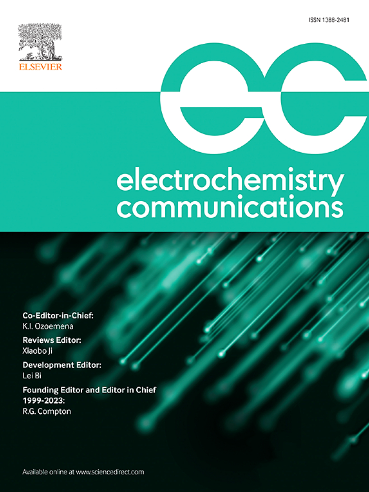Highlighting real capacitor behavior in liquid ammonia of passivated n-InP by thin Polyphosphazene film
IF 4.2
3区 工程技术
Q2 ELECTROCHEMISTRY
引用次数: 0
Abstract
Semiconductor/liquid junctions exhibit distinctive electrochemical behaviors. This study investigates the passivation of lightly doped (1015 cm−3) n-type indium phosphide (n-InP) in liquid ammonia. Under photoanodic conditions, a Polyphosphazene (PPP) film forms on the InP surface. The formation of PPP ultra-thin film was confirmed through X-ray photoelectron spectroscopy. Cyclic voltammetry revealed a progressive positive shift in the onset potential for photocurrent, indicating successful progressive passivation. Capacitance–voltage measurements showed a constant capacitance (≈ 1.3 μF.cm−2) over 400 mV after passivation, signifying the formation of a stable capacitor-like structure at the interface in a large potential domain. Cyclic voltammograms acquired at different scan rates demonstrated that the current was proportional to the scan rate, confirming the capacitive nature of the InP/PPP interface. The same interface capacitance was also quantified from the slope of the linear fit between the current and scan rate, showing that the PPP film acts as a dielectric layer with a fixed capacitance. This capacitor-like behavior leads the semiconductor in accumulation configuration from open circuit potential to lower potentials. To balance the electrical charges, the PPP should be positively charged in this range of potentials. The capacitance was used to determine the relative dielectric constant of the PPP film, which was found to be approximately 6.9. This value is consistent with that of polymeric materials exhibiting good insulating properties, further supporting the effective dielectric behavior of the PPP layer. This capacitor-like behavior alters the electrochemical response and stability of the InP/NH₃ Liq. interface, underscoring its potential for innovative electrochemical applications.
用聚磷酰胺薄膜钝化n-InP在液氨中的真实电容行为
半导体/液体结表现出独特的电化学行为。本研究研究了轻掺杂(1015 cm−3)n型磷化铟(n-InP)在液氨中的钝化。在光阳极条件下,在InP表面形成聚磷腈(PPP)膜。通过x射线光电子能谱证实了PPP超薄膜的形成。循环伏安法显示,光电流的起始电位逐渐正移,表明成功的渐进式钝化。钝化后的电容-电压测量结果表明,钝化后的电容在400 mV范围内保持恒定(≈1.3 μF.cm−2),表明在大电位域界面处形成了稳定的类电容结构。在不同扫描速率下获得的循环伏安图表明,电流与扫描速率成正比,证实了InP/PPP接口的电容性。从电流与扫描速率之间的线性拟合斜率也可以量化相同的界面电容,表明PPP膜作为具有固定电容的介电层。这种类似电容器的行为导致半导体处于从开路电位到低电位的积累结构。为了平衡电荷,PPP应该在这个电位范围内带正电荷。利用电容值确定了PPP膜的相对介电常数,该常数约为6.9。该值与具有良好绝缘性能的聚合物材料的值一致,进一步支持了PPP层的有效介电性能。这种类似电容器的行为改变了InP/NH₃Liq.界面的电化学响应和稳定性,强调了它在创新电化学应用方面的潜力。
本文章由计算机程序翻译,如有差异,请以英文原文为准。
求助全文
约1分钟内获得全文
求助全文
来源期刊

Electrochemistry Communications
工程技术-电化学
CiteScore
8.50
自引率
3.70%
发文量
160
审稿时长
1.2 months
期刊介绍:
Electrochemistry Communications is an open access journal providing fast dissemination of short communications, full communications and mini reviews covering the whole field of electrochemistry which merit urgent publication. Short communications are limited to a maximum of 20,000 characters (including spaces) while full communications and mini reviews are limited to 25,000 characters (including spaces). Supplementary information is permitted for full communications and mini reviews but not for short communications. We aim to be the fastest journal in electrochemistry for these types of papers.
 求助内容:
求助内容: 应助结果提醒方式:
应助结果提醒方式:


